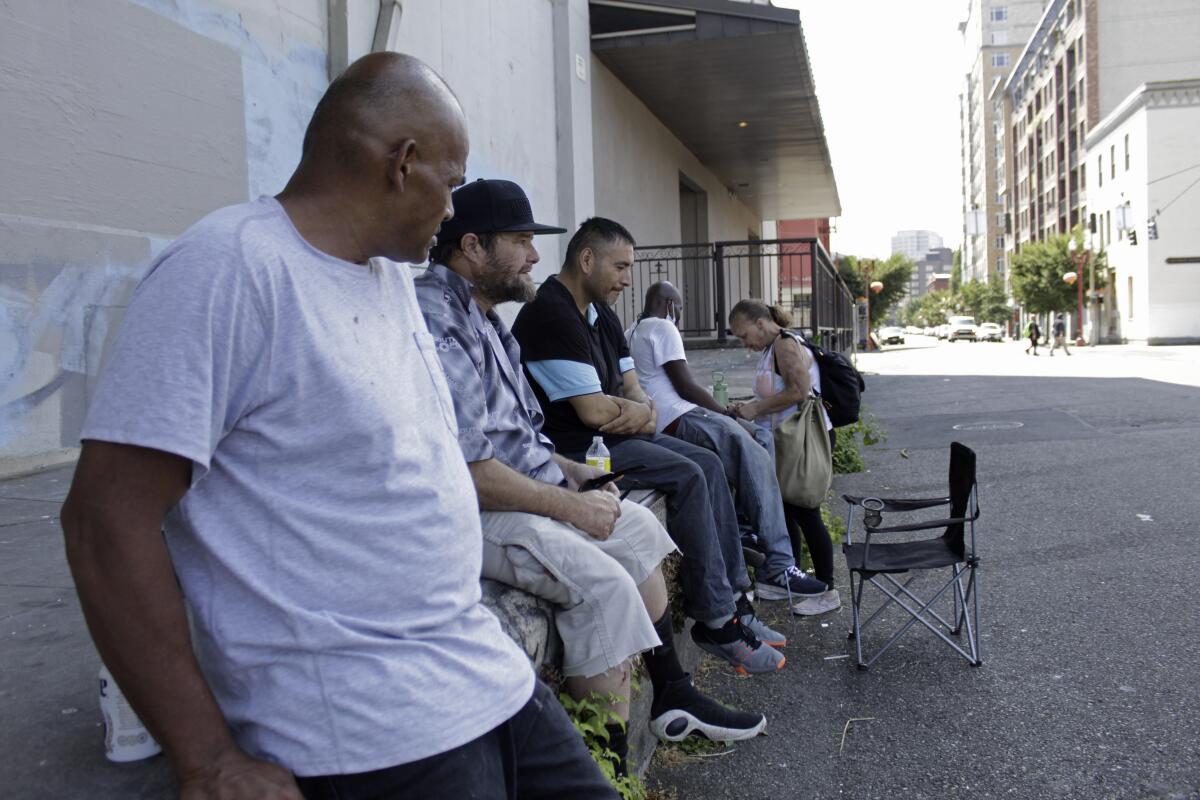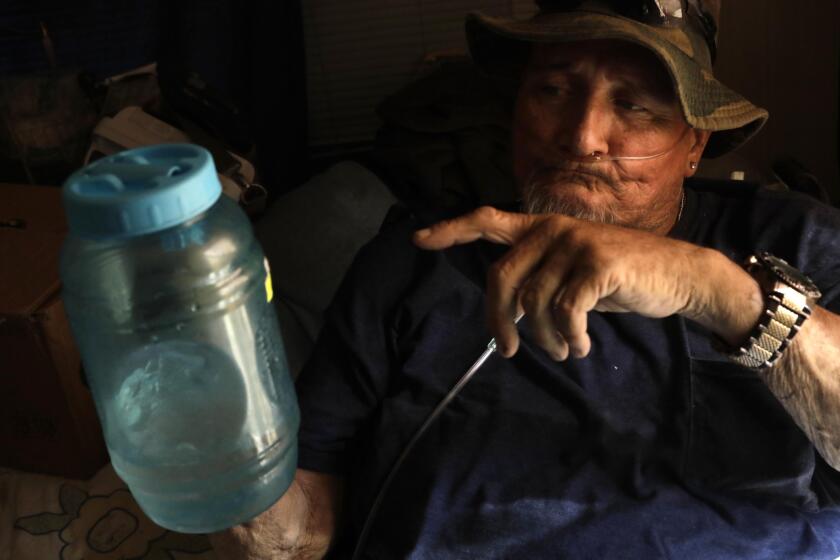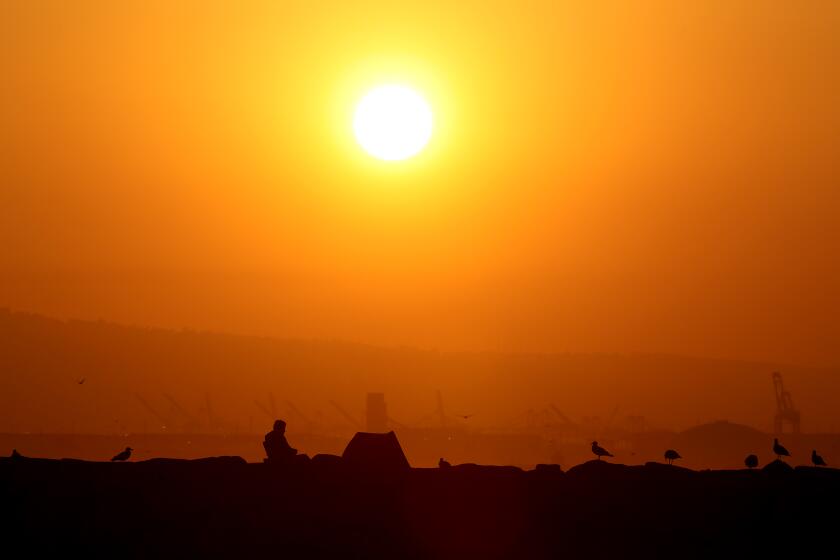Temperatures could hit triple digits again in Pacific Northwest

- Share via
PORTLAND, Ore. — Heat wave duration records could be broken in the Pacific Northwest this week and authorities are expanding capacity at some cooling centers as temperatures near triple digits are forecast to extend into the weekend.
“For the next several days through Saturday we’re going to be within a few degrees of 100 every day,” said Colby Neuman, a meteorologist for the National Weather Service in Portland, Ore.
Temperatures in Oregon’s largest city are forecast to soar to 101 degrees again on Friday. On Tuesday, Portland set a daily record of 102.
Seattle on Tuesday also reported a new record daily high of 94. The heat spell was forecast to last into Saturday in western Washington as well.
The National Weather Service has extended the excessive heat warnings from Thursday through Saturday evening.
The duration of the heat wave puts Portland “in the running” for tying its longest streak of six consecutive days of 95 or higher, Neuman said.
Climate change is fueling longer heat waves in the Pacific Northwest, a region where weeklong heat spells were historically rare, according to climate experts.
Read all of our coverage about how California is neglecting the climate threat posed by extreme heat.
On Wednesday, the Oregon State Medical Examiner’s Office said at least two people have died from suspected hyperthermia during the heat wave, KGW reported. One death occurred in Portland on Monday, the Multnomah County Medical Examiner’s Office said. The state medical examiner’s office said the heat-related death designation is preliminary and could change after further investigation.
Heat-related 911 calls in Portland have tripled in recent days, from an estimated eight calls on Sunday to 28 calls on Tuesday, said Dan Douthit, a spokesperson for the city’s Bureau of Emergency Management. Most calls involved a medical response, Douthit added.
Multnomah County said more people have been visiting emergency departments for heat-related symptoms.
Emergency department visits “have remained elevated since Sunday,” the county said in a statement. “In the past three days, hospitals have treated 13 people for heat illness, when they would normally expect to see two or three.”
People working or exercising outside, along with older people, were among those taken to emergency departments, the statement added.
People in Portland’s iconic food cart industry are among those who work outside. Many food trucks have shut down as sidewalks sizzle.
Rico Loverde, the chef and owner of the food cart Monster Smash Burgers, said the temperature inside his cart is generally 20 degrees hotter than the outdoor temperature, making it 120 inside his tiny business this week.
Significant investment to enhance community and health-system resilience can reduce the deaths associated with heat exposure.
Loverde said he closes if it reaches above 95 because his refrigerators overheat and shut down. Last week, even with slightly cooler temperatures in the mid-90s, Loverde got heat stroke from working in his cart for hours, he said.
“It hurts; it definitely hurts. I still pay my employees when we’re closed like this because they have to pay the bills too, but for a small business it’s not good,” he said Tuesday.
Multnomah County said its four emergency overnight cooling shelters were at half capacity on Tuesday with 130 people spending the night. But anticipating more demand, officials decided to expand capacity at the four sites to accommodate nearly 300 people.
William Nonluecha, who lives in a tent in Portland, sought out shade with some friends as the temperature soared Wednesday afternoon. Nonluecha was less than a minute’s walk from a cooling shelter set up by local authorities but wasn’t aware it was open. He said the heat in his tent was almost unbearable.
His friend Mel Taylor, who was homeless last year but now has transitional housing, said during a record-breaking heat wave last summer a man in a tent near his died from heat exhaustion and no one realized it. He’s afraid the same thing might happen this summer.
“He was in his tent for like a week and the smell, that’s how they figured out that he was dead,” Taylor said. “It’s sad.”
Q&A with Marta Segura, L.A.’s first heat officer. She will help develop cooling strategies and an early warning system for scorching temperatures.
Residents and officials in the Northwest have been trying to adjust to the likely reality of longer, hotter heat waves after last summer’s deadly “heat dome” weather phenomenon that prompted record temperatures and deaths.
About 800 people died in Oregon, Washington and British Columbia during that heat wave, which hit in late June and early July. The temperature at the time soared to an all-time high of 116 in Portland and smashed heat records across the region. Many of those who died were older and lived alone.
Other regions of the U.S. often experience temperatures of 100 degrees. But in regions like the Pacific Northwest, people are not as acclimated to the heat and are more susceptible to it, said Craig Crandall, a professor of internal medicine at the University of Texas Southwestern Medical Center.
“There’s a much greater risk for individuals in areas such as the Northwest to have higher instances of heat-related injuries and death,” Crandall said.
Officials in Seattle and Portland on Tuesday issued air quality advisories expected to last through Saturday, warning that smog may reach levels that could be unhealthy for sensitive groups.
Farther south, the National Weather Service issued a heat advisory on Wednesday for western Nevada and northeast California that is set to last from the late Thursday morning until Saturday night. Across the region, near-record daytime high temperatures will range from 99 to 104 degrees.
More to Read
Sign up for Essential California
The most important California stories and recommendations in your inbox every morning.
You may occasionally receive promotional content from the Los Angeles Times.













